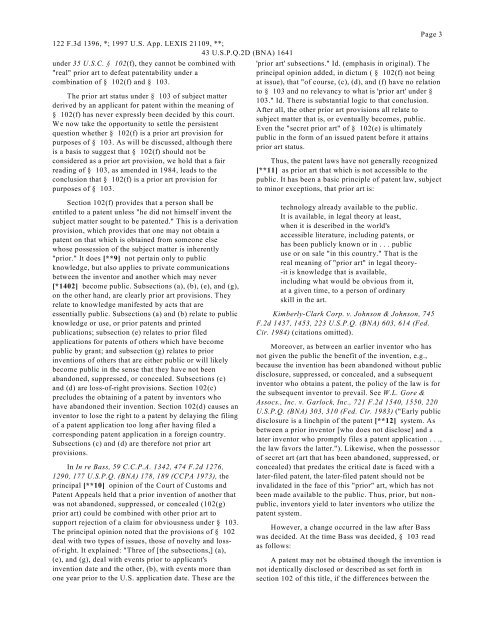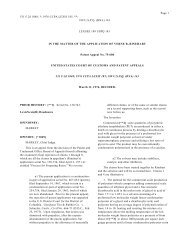ODDZON PRODUCTS, INC., Plaintiff-Appellant, v. JUST TOYS, INC.
ODDZON PRODUCTS, INC., Plaintiff-Appellant, v. JUST TOYS, INC.
ODDZON PRODUCTS, INC., Plaintiff-Appellant, v. JUST TOYS, INC.
Create successful ePaper yourself
Turn your PDF publications into a flip-book with our unique Google optimized e-Paper software.
122 F.3d 1396, *; 1997 U.S. App. LEXIS 21109, **;43 U.S.P.Q.2D (BNA) 1641under 35 U.S.C. § 102(f), they cannot be combined with"real" prior art to defeat patentability under acombination of § 102(f) and § 103.The prior art status under § 103 of subject matterderived by an applicant for patent within the meaning of§ 102(f) has never expressly been decided by this court.We now take the opportunity to settle the persistentquestion whether § 102(f) is a prior art provision forpurposes of § 103. As will be discussed, although thereis a basis to suggest that § 102(f) should not beconsidered as a prior art provision, we hold that a fairreading of § 103, as amended in 1984, leads to theconclusion that § 102(f) is a prior art provision forpurposes of § 103.Page 3'prior art' subsections." Id. (emphasis in original). Theprincipal opinion added, in dictum ( § 102(f) not beingat issue), that "of course, (c), (d), and (f) have no relationto § 103 and no relevancy to what is 'prior art' under §103." Id. There is substantial logic to that conclusion.After all, the other prior art provisions all relate tosubject matter that is, or eventually becomes, public.Even the "secret prior art" of § 102(e) is ultimatelypublic in the form of an issued patent before it attainsprior art status.Thus, the patent laws have not generally recognized[**11] as prior art that which is not accessible to thepublic. It has been a basic principle of patent law, subjectto minor exceptions, that prior art is:Section 102(f) provides that a person shall beentitled to a patent unless "he did not himself invent thesubject matter sought to be patented." This is a derivationprovision, which provides that one may not obtain apatent on that which is obtained from someone elsewhose possession of the subject matter is inherently"prior." It does [**9] not pertain only to publicknowledge, but also applies to private communicationsbetween the inventor and another which may never[*1402] become public. Subsections (a), (b), (e), and (g),on the other hand, are clearly prior art provisions. Theyrelate to knowledge manifested by acts that areessentially public. Subsections (a) and (b) relate to publicknowledge or use, or prior patents and printedpublications; subsection (e) relates to prior filedapplications for patents of others which have becomepublic by grant; and subsection (g) relates to priorinventions of others that are either public or will likelybecome public in the sense that they have not beenabandoned, suppressed, or concealed. Subsections (c)and (d) are loss-of-right provisions. Section 102(c)precludes the obtaining of a patent by inventors whohave abandoned their invention. Section 102(d) causes aninventor to lose the right to a patent by delaying the filingof a patent application too long after having filed acorresponding patent application in a foreign country.Subsections (c) and (d) are therefore not prior artprovisions.In In re Bass, 59 C.C.P.A. 1342, 474 F.2d 1276,1290, 177 U.S.P.Q. (BNA) 178, 189 (CCPA 1973), theprincipal [**10] opinion of the Court of Customs andPatent Appeals held that a prior invention of another thatwas not abandoned, suppressed, or concealed (102(g)prior art) could be combined with other prior art tosupport rejection of a claim for obviousness under § 103.The principal opinion noted that the provisions of § 102deal with two types of issues, those of novelty and lossof-right.It explained: "Three of [the subsections,] (a),(e), and (g), deal with events prior to applicant'sinvention date and the other, (b), with events more thanone year prior to the U.S. application date. These are thetechnology already available to the public.It is available, in legal theory at least,when it is described in the world'saccessible literature, including patents, orhas been publicly known or in . . . publicuse or on sale "in this country." That is thereal meaning of "prior art" in legal theory--it is knowledge that is available,including what would be obvious from it,at a given time, to a person of ordinaryskill in the art.Kimberly-Clark Corp. v. Johnson & Johnson, 745F.2d 1437, 1453, 223 U.S.P.Q. (BNA) 603, 614 (Fed.Cir. 1984) (citations omitted).Moreover, as between an earlier inventor who hasnot given the public the benefit of the invention, e.g.,because the invention has been abandoned without publicdisclosure, suppressed, or concealed, and a subsequentinventor who obtains a patent, the policy of the law is forthe subsequent inventor to prevail. See W.L. Gore &Assocs., Inc. v. Garlock, Inc., 721 F.2d 1540, 1550, 220U.S.P.Q. (BNA) 303, 310 (Fed. Cir. 1983) ("Early publicdisclosure is a linchpin of the patent [**12] system. Asbetween a prior inventor [who does not disclose] and alater inventor who promptly files a patent application . . .,the law favors the latter."). Likewise, when the possessorof secret art (art that has been abandoned, suppressed, orconcealed) that predates the critical date is faced with alater-filed patent, the later-filed patent should not beinvalidated in the face of this "prior" art, which has notbeen made available to the public. Thus, prior, but nonpublic,inventors yield to later inventors who utilize thepatent system.However, a change occurred in the law after Basswas decided. At the time Bass was decided, § 103 readas follows:A patent may not be obtained though the invention isnot identically disclosed or described as set forth insection 102 of this title, if the differences between the





